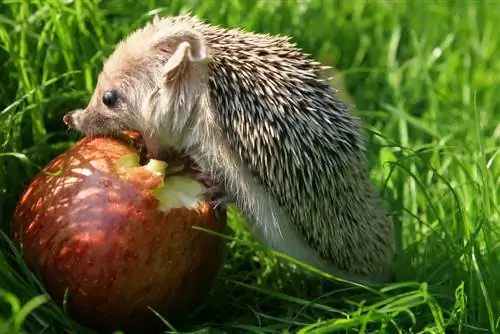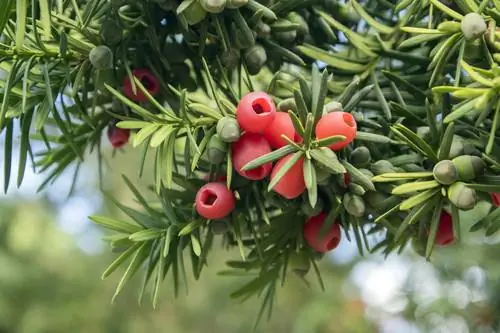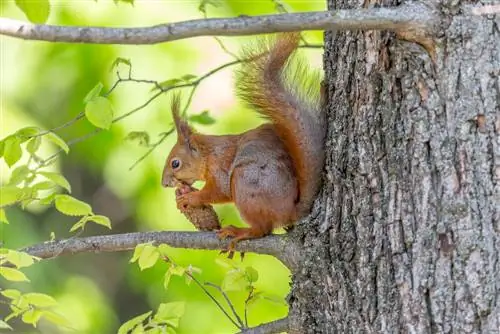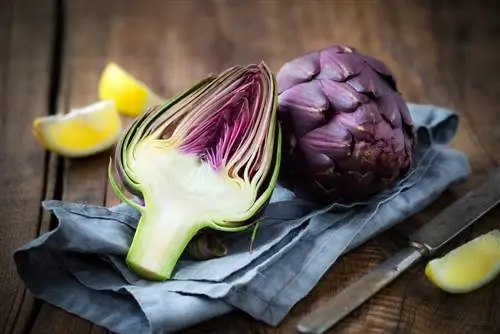- Author admin [email protected].
- Public 2023-12-24 06:09.
- Last modified 2025-01-23 11:22.
Hedgehogs are part of the picture in gardens and parks. Echinoderms normally lead a hidden life. Her diet seems to be a secret. Many nature lovers don't know what hedgehogs like to eat because of the numerous advice.
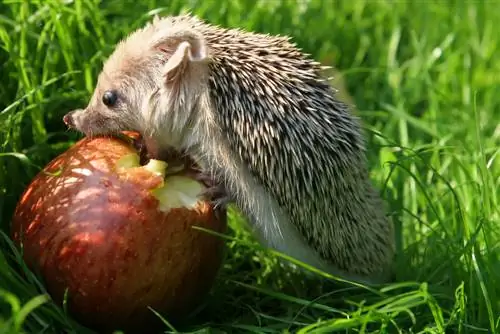
What do hedgehogs eat in nature?
Hedgehogs mainly eat insects such as ground beetles, millipedes and spiders, as well as larvae, annelids and snails. Occasionally they also eat carrion, frogs, mice, berries and fallen fruit. Hedgehogs may only be fed in exceptional cases, for example with cat food, but never with milk.
What do hedgehogs eat in nature?
The natural menu is influenced by the season and weather conditions. Their digestive system is specialized for certain foods, although the animals occasionally appear as omnivores. Don't let this confuse you if you need to feed a hedgehog in need.
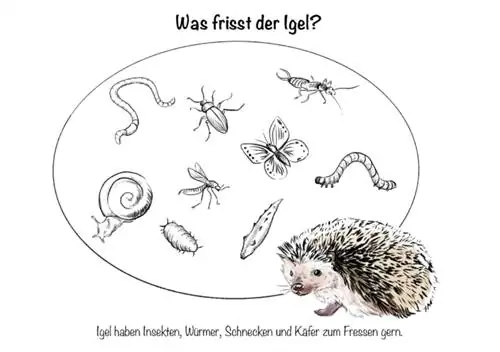
Diet in the wild
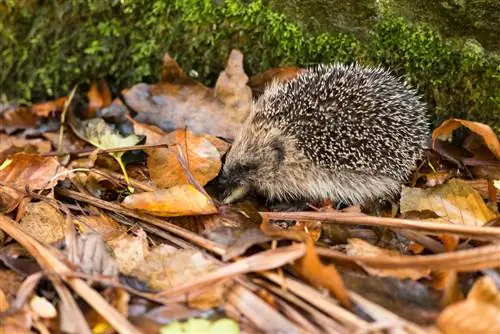
In nature, hedgehogs mainly eat snails, worms and other small insects
Hedgehogs have a very simple digestive tract that consists of a tube. Compared to the length of their body, their intestines are very short. An appendix is missing. The digestive system severely restricts the diet, even if hedgehogs occasionally appear to be omnivores. Echinoderms are primarily insectivores. As nocturnal creatures, they search for invertebrates in nature under the cover of darkness.
Main food:
- Insects: ground beetles, millipedes and spiders
- Larvae: Butterfly caterpillars
- molluscs: annelids and snails
Occasionally the spiny four-legged friends eat carrion or eat vertebrates. It happens that hedgehogs hunt frogs or mice. On a smaller scale, plant food sources are used in the garden to meet water needs or when the supply of invertebrates is low. This includes fallen fruit or roots. A purely vegetarian diet is not suitable for the animals. Your gastrointestinal tract cannot break down the plant-based food, so most of it is excreted undigested.

Food spectrum over the course of the year
Hedgehogs are considered adaptable. The clever echinoderms know about the food available to them in the different seasons. They browse through different sources where their main food is found. Due to their preference for sweets, hedgehogs are occasionally observed eating berries and fallen fruit.
| What do hedgehogs eat? | Influencers | |
|---|---|---|
| in spring | Earthworms, millipedes and snails; occasionally bird eggs | Rainfall drives insects and worms to the soil surface |
| in summer | Beetles and, if available, slugs | Drought favors heat-loving beetle species |
| in autumn | Apple, fruit and root residues | Insects in rotting plant parts and overripe fallen fruit |
| in winter | no food intake | Ground frost and snow limit insect diversity |
Excursus
Is there actually a food shortage in dry summer months?
The Hedgehog Center Zurich has addressed this question, as feeding hedgehogs is often advised during hot periods. Earthworms make up a small part of a hedgehog's diet. When drought occurs, they retreat into deeper soil layers and are therefore no longer available as a food source.
The situation is different with the insects that make up the majority of hedgehog food. Warm weather has a positive influence on the development times of numerous heat-loving species. This means that certain beetles develop more quickly in the hot summer months and can therefore reproduce more frequently. Several generations occur in a shorter period of time, which multiplies the hedgehog's food supply.
Can I feed hedgehogs?
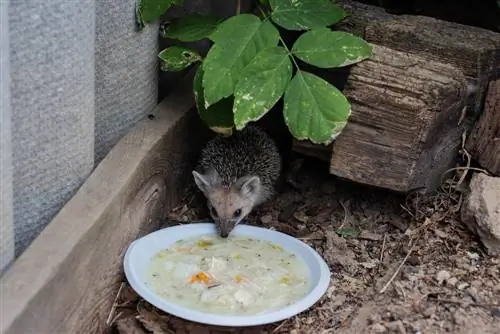
Wild hedgehogs should not be fed
In general, wild animals should not be fed. The habituation effect is too great, so that the animals quickly get used to the new and easily accessible food source. Even if young hedgehogs beg you with their heart-melting eyes, do not feed them. They need the opportunity to get their own food. In these three exceptions it makes sense and is necessary to support hedgehogs by feeding them:
- Winter foundlings: Hedgehogs woke up from hibernation too early and can't find food in the frozen ground
- Weaklings: Before the onset of winter, young hedgehogs weigh less than 500 grams
- Illness: Animals are emaciated and suffer from illness
Reasons against feeding
Domestic hedgehogs go through a rhythm throughout the year that they have to adhere to in order to survive. If the animals are fed extensively in autumn and winter, their metabolism remains active. There is a higher risk that they will not go into hibernation and will have to rely on solid food sources until next spring.
Hedgehogs should generally not be fed as they find enough food in nature. A small bowl of water is important in hot summer months.
Hedgehog in distress: What can a hedgehog eat?
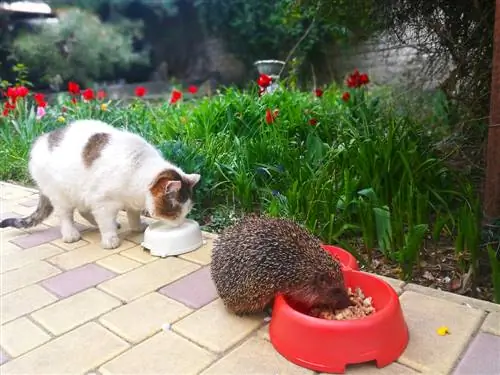
Cat food is not good food for hedgehogs
No substitute food comes close to the quality of natural hedgehog food. If it happens between spring and autumn that hedgehogs cannot find enough food, you can consider emergency feeding. Remember that a feeding station must be kept clean. Dirty bowls pose a higher risk of pathogens multiplying.
Tip
Cat food is an alternative for exceptional cases. It is not an ideal food because it is not adapted to the needs of hedgehogs as the main insect eaters but to the needs of cats.
What do little hedgehogs eat?
A baby hedgehog that weighs less than 120 grams is not yet used to solid food. Such foundlings receive puppy substitute milk in breeding stations. In any case, feeding cow's milk should be avoided. The lactose in it cannot be broken down in the intestines, so the little hedgehog gets diarrhea. In the worst case scenario, he dies as a result of malnutrition.
What shouldn't a hedgehog eat?
Numerous hedgehog guides report that homemade muesli is a varied substitute food. You should avoid such experiments. The simply structured gastrointestinal tract is unable to utilize food. Fructose leads to the formation of tartar and tooth decay. As a result, adult animals often suffer from tooth loss and die from starvation.
- What hedgehogs are not allowed to eat: Milk, cheese, quark, yoghurt and hazelnut biscuits
- What they can't use: Raisins, apples, bananas and avocados
- What echinoderms don't eat: carrots, onions, lettuce, potatoes, leaves
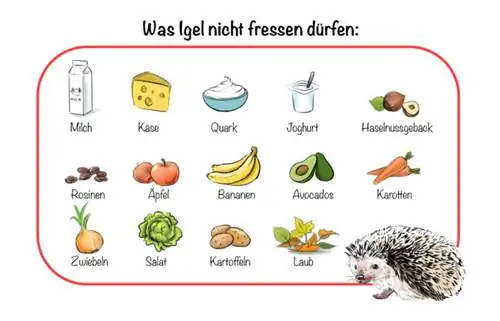
What do hedgehogs drink?
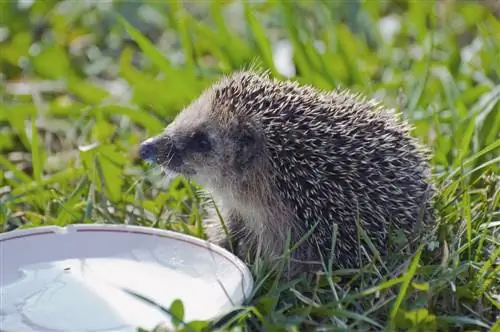
Hedgehogs should never drink milk!
In nature, animals meet their fluid needs by drinking water from puddles, streams and ponds. Hedgehogs are lactose intolerant and cannot break down milk sugar.
Tip
Weakened hedgehogs can be boosted with a mixture of lukewarm chamomile tea and a little honey. However, the sweetener is not suitable for long-term feeding.
Frequently asked questions
Are hedgehogs good against snails in the garden?
Snails are on the menu of hedgehogs. These are destroyed in spring and summer when the moist garden beds offer optimal living conditions for the molluscs. However, hedgehogs are no guarantee of a snail-free garden. Only ten percent of the insectivore's entire food spectrum is made up of snails. Since it eats snail clutches, it can curb the spread of crop pests somewhat.
What kind of snails do hedgehogs eat?
Snails are considered emergency food for echinoderms. They are less important in the food spectrum. Which species are captured depends on the supply. During spring, hedgehogs eat snails that live among the moist grass. Later in the year, slugs and slugs are not ignored either.
Snail types of the hedgehog diet:
- Tiger snail (Limax maximus)
- Garden snail (Arion hortensis)
- Ground snail (Tandonia budapestensis)
Slugs are largely avoided. In Germany, hedgehogs are among the mammals that eat the Spanish slug (also called nasturtium). Before it becomes edible, the animal rolls its prey on the ground. The process, which takes up to half an hour, is used to remove the bitter-tasting mucus.
How can I properly help hedgehogs?
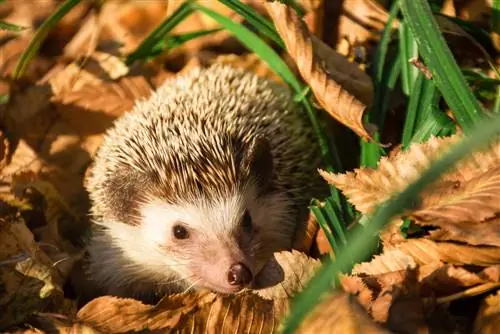
Leaf piles are the ideal wintering place for hedgehogs
Much more important than supplementary feeding is a natural garden design so that the hedgehog has a natural retreat with abundant food sources. Make sure to plant with native shrub species. Dead wood provides shelter in undisturbed areas of the garden and provides overwintering quarters. Leave piles of leaves lying around and grass growing until spring. Old fruit trees that no longer bear well are considered biodiversity hotspots. They provide a habitat for heat-loving insects.
Can I keep hedgehogs in captivity?
Echinoderms are among the specially protected animal species and must not be captured and kept in the home for no reason. In exceptional cases, temporary accommodation is permitted if the animals are sick or weak and would not survive the winter without human help.
Greens against an attitude:
- Temperatures that are too warm causes metabolism to go into overdrive
- Energy reserves are used up too quickly
- Releasing too late poses the risk that territories are already occupied
- overwintered young hedgehogs have no experience in catching live prey
Anyone who takes in a young animal for one winter runs the great risk that it will have a worse chance of survival in the coming year. It may be that the hedgehog will need human help again next winter. In nature, the cold season acts as a selection of well-adapted and weak hedgehogs.
What do hedgehogs like to eat most?
Hedgehogs particularly like to stay in piles of musty dead wood to look for their main food there. They like to eat insects that live under the bark and on the soil surface. These provide the echinoderms with proteins, trace elements and vitamins. Since their intestines digest the food after just 20 hours, a hedgehog has to fill its stomach at least twice a night.

